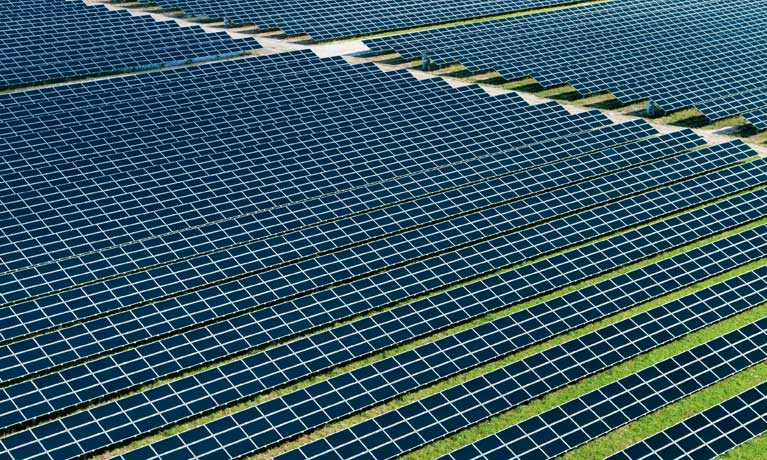First Solar reported net sales of $2.7 billion for 2020, a drop from the nearly $3.1 billion it reported a year earlier.
Operating expenses for the year improved from almost $711 million in 2019 to $363 million in 2020. The 2019 expenses were skewed by a charge related to settling shareholder litigation over alleged stock price manipulation.
Full-year net income was just under $400 million, or $3.73 a share. That compared to a loss of almost $115 million, or $1.09 a share, in 2019.
Net fourth quarter sales were $0.6 billion. That was down $0.3 billion from the prior quarter. The company said the decline stemmed from higher international project sales in the third quarter, which were partially offset by increased module sales in the fourth quarter. The company said its fourth quarter net income per share was $1.08.

Analysts had expected fourth-quarter earnings of $1.24 a share on revenue of $715 million.
Mark Widmar, CEO, said that the company faced challenges during 2020, including “continued intense competition” across the crystalline PV supply chain as well as “unforeseen challenges related to the pandemic.”
Orders for 2021 got a boost with word that First Solar will supply up to 2.4 GW of its Series 6 photovoltaic solar modules to Intersect Power. The deal, announced Feb. 26, is one of the largest orders for the modules to date.
Modules will be deployed to seven projects, with deliveries scheduled for 2022 and 2023. The deal with Intersect Power includes options to add almost 400 MW more capacity, subject to the projects’ final designs. Intersect Power placed a 1.7 GW order for Series 6 modules in 2019.
First Solar said it is forecasting net sales for 2021 of between $2.85 billion to $3.0 billion. That includes $2.45 billion to $2.55 billion of module segment sales. Operating income is forecasted to be in the range of $545 million to $640 million. The company also said it expects net income per share to range from $4.05 to $4.75.
First Solar has suggested that it is evaluating further U.S. manufacturing expansion, “contingent on the right policy environment.”
Green hydrogen plant
Plug Power said it will build a $290 million hydrogen production facility and electric substation in the New York Science, Technology and Advanced Manufacturing Park (STAMP) in western New York State. The project includes a 450 MW electrical substation that will service the entire STAMP site. The hydrogen production plant is intended to produce 45 metric tons of green liquid hydrogen daily for markets in the Northeast. The plant will use 120 MW of Plug Power’s PEM electrolyzers to make the hydrogen using hydropower. The New York plant joins an existing Tennessee plant in a network that aims to supply 500 tons per day of green hydrogen by 2025.
Small-scale climate models
Assets related to energy infrastructure tend to be far-flung; solar PV assets in particular may sprawl over hundreds or thousands of acres, much of it in rural and isolated regions.
With that in mind, the U.S. Department of Energy’s Argonne National Laboratory is developing small-scale local climate-change models. California utility Pacific Gas & Electric will use them as part of its planning to avoid wildfire disasters.
The Argonne-developed model projects future climate in a 12-km grid across the entire U.S.
Data includes factors that impact fire risk such as high wind speeds, low humidity, and soil moisture. The California utility will combine those data with existing science on how climate change will affect heat and precipitation.
The growth of solar energy capacity across California puts the often-sprawling arrays at increased wildfire risk, according to Andrew Sundling of PVEL. He spoke on insurance risk at a recent online event hosted by the National Renewable Energy Laboratory. The range of damage to solar PV panels can sometimes be obvious, such as scorched backsheets, warped tracker torque tubes, embrittled metal structures, and melted or cracked inverter enclosures, junction boxes, and connector cables.
Less obvious damage may occur from fast-moving brush fires that result in thermal stress. In that case, cell-level cracks, microcracks, scratches, and heat spots may not be visible, but can still trim energy yield and cause safety issues over time.
This content is protected by copyright and may not be reused. If you want to cooperate with us and would like to reuse some of our content, please contact: editors@pv-magazine.com.









By submitting this form you agree to pv magazine using your data for the purposes of publishing your comment.
Your personal data will only be disclosed or otherwise transmitted to third parties for the purposes of spam filtering or if this is necessary for technical maintenance of the website. Any other transfer to third parties will not take place unless this is justified on the basis of applicable data protection regulations or if pv magazine is legally obliged to do so.
You may revoke this consent at any time with effect for the future, in which case your personal data will be deleted immediately. Otherwise, your data will be deleted if pv magazine has processed your request or the purpose of data storage is fulfilled.
Further information on data privacy can be found in our Data Protection Policy.